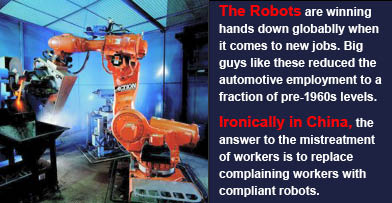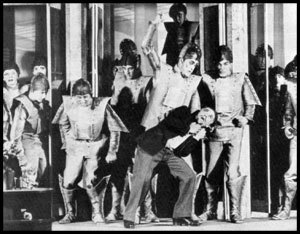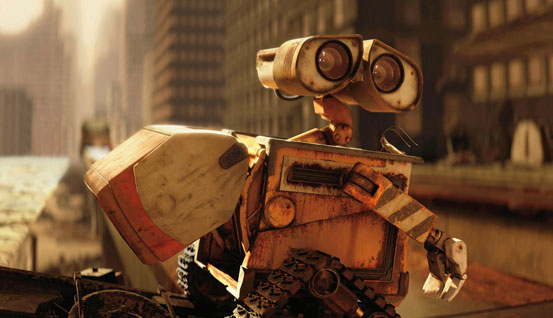They’ve Fundamentally Changed The Nature of Employment, Unemployment, Future Employment, and Markets
The term “Robot” was coined in 1920 in the stageplay, R.U.R. In this story, the robots take over the world, and now it’s really happening. They will now take over your world, and your organization will never be the same!
For a tiny slice of workers today, the opportunity is huge in terms of new opportunities, wages, and upward mobility—not so for millions of traditional employees.
For those 21st Century employees who can “run the robots,” the future has never been brighter. If we can find, nurture and keep this employee, they are fundamental to scaling organizations. But how do we do that?
The long predicted robot takeover has arrived in the 21st Century, and they’re killing traditional employment and creating a startling new profile of the people you must hire to succeed.
The general, global trend toward fewer people working for declining wages was a huge dynamic even before the 2008 financial debacle. It’s a baffling and discouraging reality, yet it offers opportunities for companies who know how to compete with their people.
If you’ve been scratching your head about how difficult it is to put together high performing organizational teams, here is an overlooked, underreported factor. It is the accelerating need for fewer people with specialized, incredible skills that is driving many of the organizational dynamics of today.
Yet an amazing number of people working to enter the workforce and succeed seem oblivious to the rules of the new reality of the 21st Century.
We are now in full flight of running from the robots we began to create over 30 years ago at the dawn and acceleration of the digital age.
Robots will probably never have the humanoid look of an R2D2, but they are here today, embedded in the form of the technology we use. They go beyond the technology that has enhanced human performance in the decades since the 1980s. They are taking the place of humans. They are now robotic in that they do a wide range of functions, from assembling things in manufacturing to making critical decisions that cadres of supervisors and managers used to make.
 Huge numbers of people have now become obsolete, and the employees we need to “run the robots”–instead of running from them–are getting harder to find all the time. These unique employees are rare.
Huge numbers of people have now become obsolete, and the employees we need to “run the robots”–instead of running from them–are getting harder to find all the time. These unique employees are rare.
Interestingly enough, the takeover of robots has been long predicted since the 1920s when Czech playwright, Karel Capek, wrote a play called R.U.R. (Rossum’s Universal Robots) in which he invented the term “robot.”
Capek’s version of “robots” looked a lot like their human counterparts. At first they were content to serve humans, but then they got really mean and annihilated almost the entire human race. Capek’s term “robot” soon became part of the world dictionary.

The prevailing law that technology creates more jobs than it eliminates used to be true, but is now false. Huge numbers of people who were needed to run the processes and make organizational decisions are gone forever. They have been eliminated by sophisticated decision making algorithms. Those eliminated far exceed the number of jobs created.
The traditional way of thinking about how an economy rebounds is no longer true and doesn’t take into account the total disruptive nature of the robots we’re created. Those who have been riffed attempt to come back to a workforce where their skills don’t fit anywhere.
Former jobs in seemingly indestructible areas like project management and sales are gone–lost to sophisticated web technology. Web connectivity will eliminate much of the footwork of project management. The sales function continues to migrate online, with only the high-level deals still being done by people. There are thousands of examples like these we see each day.
For a tiny slice of workers today, there has never been more opportunity for better jobs and wages. For a large number, prospects are grim.
The new rule is that companies today are operated with a relatively small number of very uniquely qualified people–who will become fewer–who manage huge interlocking emerging technologies and robotics driven at warp speed. These are the people who will “run the robots,” instead of run from them.
Here are the facts that we must keep in mind and use to guide us as leaders.
- The robotic world is only just beginning. Artificial Intelligence (AI) will continue to decrease the number of people used to perform tasks. Most of the unemployed you will find available are not qualified to do the jobs you need them to do to move your organization forward.
- The kinds of employees you need must have the critical thinking skills to orchestrate the use of technology and robotics, and these people are found in amazingly small numbers. Overachievers who often do the hiring are frequently baffled that the people who come through the door looking for a job don’t view life through the same windshield that they do. They are in search of a 20th Century job title—not a 21st Century opportunity.
- These kinds of employees are not only difficult to find, but it is a frustrating process to sort out candidates that sound good from those who can really perform. In a world of 15% actual unemployment, people who recruit often go through hundreds of resumes to find a handful to present as candidates for hire.
- The competition for the slim number of high performance workers will continue to be expensive and brutal. Salary will be a key factor, but the ability to create a high performance environment will be an even greater challenge, and maintaining that environment will require creative approaches to workers who can choose to stay—or leave for a new job tomorrow.
- You will need competent organizational advisors and coaches to win. In order to grow and retain the kinds of employees that you need, it will be important to maintain effective staff of senior coaches. In the old days of the oil fields of Texas you put out a worker to sink or swim with the old guys who taught him the ropes. If he failed it was funny. Now failure is painfully expensive.In order to win in today’s organizational world, the people who work for you must be at the same level as professional athletes in the NFL, NBA, or other professional leagues. These people don’t perform without a constant process of coaching, enabling them to perform at a higher level. Putting people in high performing roles without coaching and feedback is disastrous.
And here are some recommendations for hiring high performance people.
- Hire the smart ones—all too often they won’t be smart enough. It is no accident that Google worships intelligence and has the success to show for it.
- Make the candidate convince you. It’s not up to you to convince them. Candidates should give you a clear idea in the interview what they will do to make a difference the first day.
- Be sure the candidate does more talking than you do. Often interviews with new candidates are more about the interviewers than the candidate. They have come to impress you—not you to impress them. Involve a cross section of people in your organization in the hiring process. Many points of view among your organization’s team members in the process are critical. Be sure to include people from many departments, people they will report to, as well as people outside the team.
- Choose the curious. If they’re not asking really good questions, they’ll never give you any good answers. Before a formal interview, provide the candidate with website information, briefings about the organization, and any other relevant information. Watch to see if the candidate comes back with questions for clarification and more information. Do they like the industry? Will they continue to learn? If they don’t ask questions that educate them about you, they’re not your person.
- Develop a system to care for and grow the employee. Our thinking about employment comes from the frontier days. If someone knew how to use a shovel or shoot a gun, they’d catch on from watching the ranch hands around them. Now in an age driven by technology, training, mentoring, and feedback should be part of a consistent program administered to everyone.
People focus on general areas, but their ability to be agile and apply their critical thinking skills is most important. They can run the robots if they are clearly smarter than the technology they manage.






